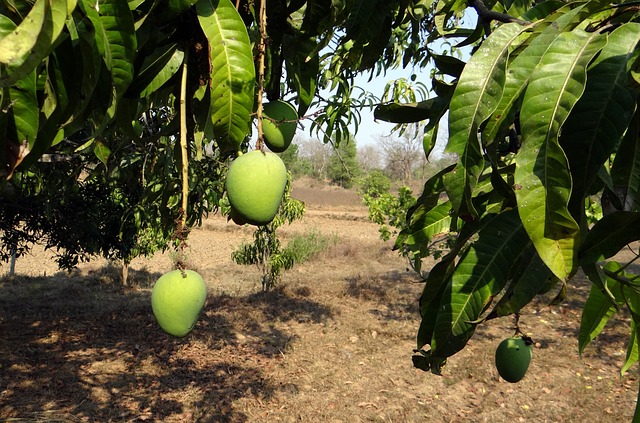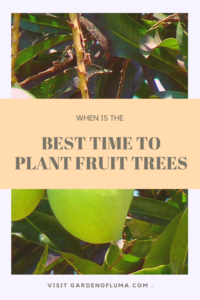When is the Best Time to Plant Fruit Trees in Hot Climates?

If you live in a hot climate where winters are fairly mild, you may wonder if it matters when you plant your fruit tree or when would be the optimal time to plant. In more temperate climates with the traditional four seasons, it’s pretty obvious that planting season is spring time or bust. As someone that gardens in the desert climate considered zone 9b, I’ve planted various fruit trees throughout the year.
When is the best time to plant a fruit tree in hot climates? The short answer? You guessed it, in the spring after any threats of frost have subsided. Another optimal time in climates with mild winters, is early fall. Even though those are the best times, if you live in a warm climate, planting can occur year round, and we will take a look at how this can be done.
Helpful Tips for Planting During the Summer
Our Arizona desert climate is scorching hot in the summer and you wouldn’t think you could plant anything during the summer months, but it can be done. A lot depends on the type of fruit tree that you’re planting and what you are going to do to support that tree throughout the summer. I’ve had success planting in temps well into the 100’s Fahrenheit. There are definitely some fruit trees I wouldn’t even consider planting in our summer months and others that will do fine. Here are a few tips to consider:
Trees to Avoid
I would not plant heat sensitive fruit trees like Avocado, Loquats, or Lychee. A lot of the more tropical fruit trees like Banana, Mango, Sapodilla, Canistel, Annona’s, Papaya, Jaboticaba, etc. should wait until other times of the year.
Trees that Can Work
I have had success planting a Pomegranate, Tropical Guava, and Jujube in hotter months. Figs, Peaches, some Citrus, Mulberries, Moringa, Barbados Cherry, Jamaican Cherry, could potentially work.
Shade
Building a shade structure can help support you’re newly planted young tree through the intense sun. This can easily be accomplished be using four tall stakes around the tree and securing a shade cloth over top, while still allowing some air flow. Check out my post on When to Use Shade Cloth in the Gardenfor more in-depth insight. I would go a bit higher on the percentage if planting in the summer months to get the tree through the summer.

Water/Feeding
I would water daily for the first week and then slowly start tapering the water schedule. I would use this liquid seaweed product at planting to help with the root development and transplant shock. Other than that, avoid any fertilizing until the tree has some time to get established. For additional questions regarding watering, take a look at my post: How to Water Fruit Trees in Hot Climates the Right Way.
Mulch
Building up a nice layer of mulch around the berm of your fruit tree can keep the root zone considerably cooler. It will help with water retention and provides nutrients to the soil as it breaks down. You can put the mulch on thick, but make sure that you keep the root flare somewhat exposed and the mulch off the trunk.
Utilize a Container
If you decide to purchase a new tree in the summer months, but don’t think it can handle being planted in the ground, consider planting in a container. At least, it won’t stay cramped in the nursery pot and is more manageable in the heat. Here is my guide on Growing Fruit Trees in Containers that you may enjoy.
Helpful Tips for Planting During the Winter
We often hear, “plant when all threats of frost have passed” which is generally a good rule of thumb. There are some fruit trees, especially those that go dormant in the winter, that aren’t really phased by some light frosts. Winter can actually be a good time to plant.
Again we are talking zones 9-11 where winters are milder, obviously if you have several inches of snow on the ground you won’t be out digging holes for planting trees. Tips for planting fruit trees during winter are:
Watering
Typically when you plant a fruit tree, you want to water frequently the first week or two after planting, but in the winter many fruit trees are in a dormant state. During this time, the trees aren’t actively growing or have considerably slowed down, so they aren’t in need of as much water. Over-watering during this time can rot the roots.
Bare Root Fruit Trees
Many temperate or stone fruit types of trees like Plums, Peaches, Cherries, Jujube, Apricots, Apples, Mulberries, etc. are shipped bare root in late winter. Bare root is simply without soil or in a pot. These should be planted immediately and can be planted in the winter.
Frost Protection
If you attempt to plant any Tropical or Subtropical fruit trees during the winter months, you’ll need to protect from frost. The same method that was used for building a shade structure can be implemented for a frost structure. Check out this video:
Microclimates
Utilizing your microclimates can aid in protecting your more cold sensitive fruit trees when planting during the winter months. Planting under the canopy of larger trees, next to structures, or under the eaves of the house, can all help in keeping your tree slightly warmer during cold snaps. For more insight on Microclimates, click here.
When Fall is Better Than Spring
Even though spring has long been considered the best time to plant a tree, fall can often be the best time for certain varieties. The thing with planting in the fall is that it allows more time for trees to acclimate before facing intense summer heat.
For more heat sensitive trees, like Loquats and Avocados, I highly recommend planting in the fall. I’ve seen many of these tree succumb to our desert heat and any advantage to get these trees off to a healthy start can make or break the tree. I planted my Bradenton Loquat in October and it has made all the difference.
The key with planting in the fall is trees that aren’t as cold sensitive, otherwise you’ll need to follow some of the tips from the winter planting section to help them through the winter.
Final Thoughts
Yes, there are some prime times to plant fruit trees, but year round planting can work. Sorry, for those that have harsh winters, you’re pretty limited on when to plant. For us hot climate gardeners, as long as you have a basic understanding of your fruit trees needs and are prepared to take a few added precautions, you don’t have to constantly be working your planting schedule around a certain day on the calendar.
Please comment below on anything that you’ve enjoyed from this post or experiences with planting fruit trees throughout the year.

There’s less chance of drought or sun scorch harming fragile, newly-planted trees. Plus, the cooler temperatures help encourage new root growth. And this effect is compounded. Since trees focus on growing new roots in fall, planting new trees now helps them develop more, stronger roots.